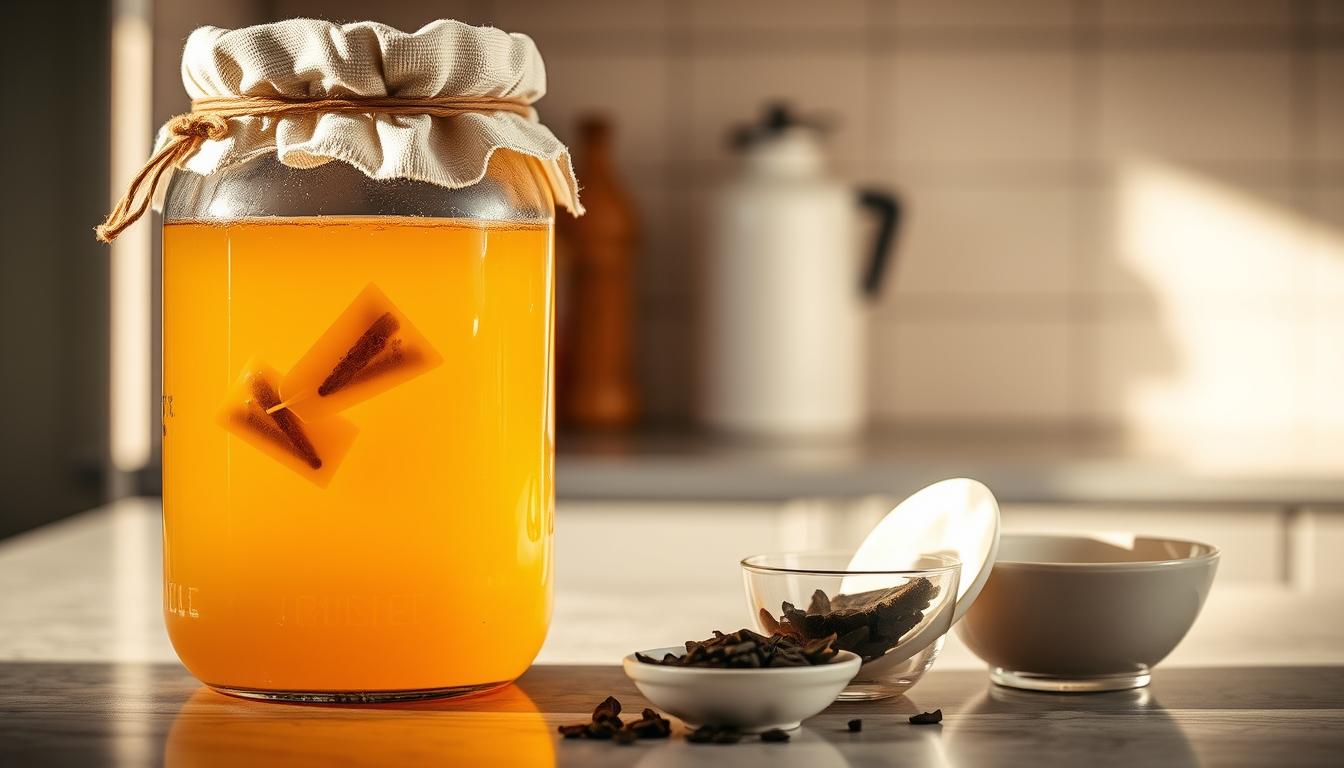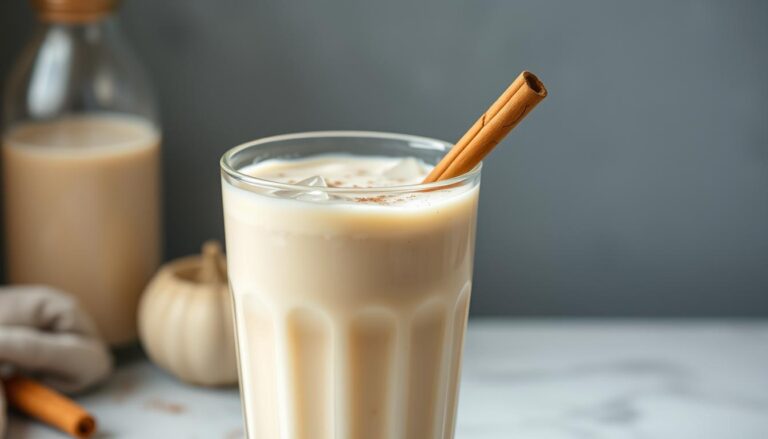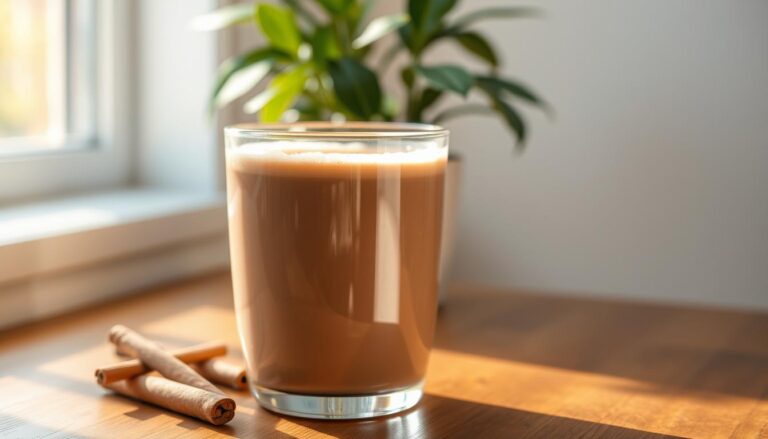Keto Kombucha Recipe with Black Tea & Stevia
Making a tasty low carb kombucha for your keto diet is easy. My recipe turns the traditional drink into a healthy choice that won’t mess up your diet.
Kombucha is great for your gut, but regular recipes have too much sugar. This keto version uses smart ingredients to keep it tangy and low in carbs.
Choosing the right ingredients is key. Black tea gives it a strong flavor, and stevia adds sweetness without raising blood sugar. This way, you get a drink that’s good for your gut and your keto diet.
Our recipe skips the sugar and SCOBY of traditional kombucha. Instead, it uses ingredients that are low in carbs. I’ll show you how to make a probiotic-rich drink that’s also keto-friendly.
This recipe is perfect for anyone who loves kombucha or is new to the keto diet. It’s a healthy drink that’s easy to make and fits well into your wellness plan.
Understanding Kombucha and the Ketogenic Diet
Exploring keto-friendly fermented drinks opens up new nutritional options. Kombucha, a probiotic drink, can be a great fit for your keto lifestyle if made right.
What is the Ketogenic Diet?
The ketogenic diet changes how your body uses energy. It cuts down carbs and boosts healthy fats. This shift puts your body into ketosis.
- Typical daily carbohydrate intake: Less than 50 grams
- Primary fuel source: Fat instead of glucose
- Metabolic goal: Efficient fat burning
How Kombucha Fits into Keto
Regular kombucha might not fit keto dieters because of sugar. But, making your own probiotic drink lets you control sugar. Just pick low-carb ingredients and watch the fermentation time.
Benefits of Combining Both
Keto-friendly fermented drinks, like kombucha, bring health perks. They help your gut, offer natural probiotics, and might boost metabolic flexibility.
- Improved digestive health
- Enhanced immune system support
- Potential weight management assistance
Learning to tweak traditional kombucha recipes lets you enjoy a tasty drink that fits your keto diet.
The Science Behind Sugar Content in Kombucha
Making a healthy gut drink like keto kombucha means knowing about sugar content. Most kombucha brands have 3 to 8 grams of carbs in an 8-ounce serving. This can be a problem for those on a ketogenic diet.
The fermentation process is key in lowering sugar levels in keto kombucha. The SCOBY (Symbiotic Culture of Bacteria and Yeast) eats sugar. It turns it into good organic acids and probiotics.
- Initial sugar content: 8-12 grams per 8 oz
- Extended fermentation time: Reduced sugar levels
- Typical final sugar content for keto: 2-3 grams per 8 oz
To measure sugar accurately, a Brix refractometer is needed. It shows sugar levels in the liquid. Knowing this helps make low-carb kombucha that’s good for your gut and fits a ketogenic diet.
Experts say fermenting kombucha for 10-14 days is best. This makes it more keto-friendly. It keeps the drink’s probiotic benefits and rich flavor.
Essential Ingredients for Keto Kombucha Recipe
Making the perfect keto kombucha needs the right ingredients. As someone who loves brewing kombucha, I’ll show you how to pick the best ones. This will help you make a tasty, low-carb drink that’s good for your keto diet.
Choosing the Right Tea Base
The base of any great kombucha is quality tea. For beginners, black tea is the best choice. Here’s what I suggest:
- Organic black tea: 12g per 3L batch
- Loose leaf is better than tea bags
- Stick to black tea for the first fermentation
Selecting Keto-Friendly Sweeteners
Keto brewers face a challenge with sugar. But, most of the sugar is gone after fermentation. This makes it okay for low-carb diets.
| Sweetener Type | Initial Fermentation | Keto Compatibility |
|---|---|---|
| White Sugar | Recommended | Sugar consumed during fermentation |
| Honey | Acceptable | Moderate carb content |
| Artificial Sweeteners | Not Recommended | Cannot support SCOBY growth |
SCOBY and Starter Tea Requirements
Your SCOBY is key to brewing kombucha. For a great batch, you need:
- A healthy SCOBY culture
- 10-15% starter tea from a previous batch
- A room temperature of 68-78°F
Tip for beginners: Use starter tea that’s unflavored and from a previous successful brew. This ensures the best fermentation.
Required Equipment and Tools
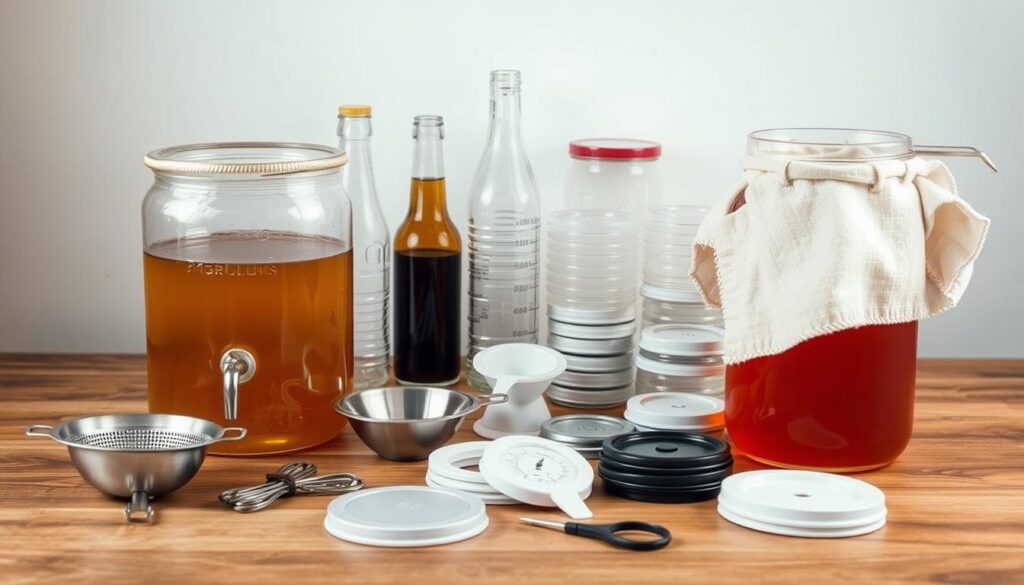
Making the perfect gut health drink needs special tools. These tools turn your kitchen into a place for making kombucha. Having the right gear makes the brewing process smooth and successful for your keto-friendly kombucha.
Choosing the right tools is key. Here are the must-haves for your brewing journey:
- Glass Fermentation Jar: 1-gallon size recommended for consistent brewing
- Breathable Cover: Tightly woven cloth with secure rubber band
- Precise Measuring Tools:
- Brix refractometer for sugar content tracking
- Digital thermometer for temperature monitoring
- pH testing strips
- Bottling Equipment:
- Glass bottles with tight-sealing lids
- Funnel for clean transfer
For those watching their budget, you can find these items in kitchen stores or online. Quality tools help you make a consistent, tasty drink that fits your keto diet.
Pro tip: Always clean your equipment well before brewing. This stops bad bacteria and keeps your kombucha brewing safe and clean.
Step-by-Step Keto Kombucha Recipe
Making homemade kombucha for a ketogenic diet needs care and patience. I’ll show you how to make a low-sugar, tasty drink that’s good for your health. Making keto kombucha means using special methods to keep sugar low while keeping the probiotics.
The secret to great keto kombucha is longer fermentation and picking the right ingredients. Unlike regular recipes, we’ll use methods that cut sugar a lot.
First Fermentation Essentials
- Black tea: 4-5 tea bags per gallon of water
- Stevia: Natural zero-carb sweetener
- Fermentation time: 30-50 days at 75-85°F
In the first fermentation, the SCOBY eats most of the sugar. This makes a low-carb drink perfect for keto fans. The longer fermentation time helps reduce sugar a lot.
Second Fermentation Strategies
- Select keto-friendly flavor enhancers
- Use glass bottles with tight seals
- Add liquid stevia for subtle sweetness
- Ferment 2-5 days at room temperature
Bottling and Storage Tips
Right bottling keeps your kombucha safe and tasty. Use clean, sterilized glass bottles with tight lids. Keep them in a cool, dark spot to keep the probiotics and avoid too much carbonation.
Your keto kombucha will be a refreshing, gut-friendly drink. It supports your diet without losing taste or nutrition.
Measuring and Monitoring Sugar Levels
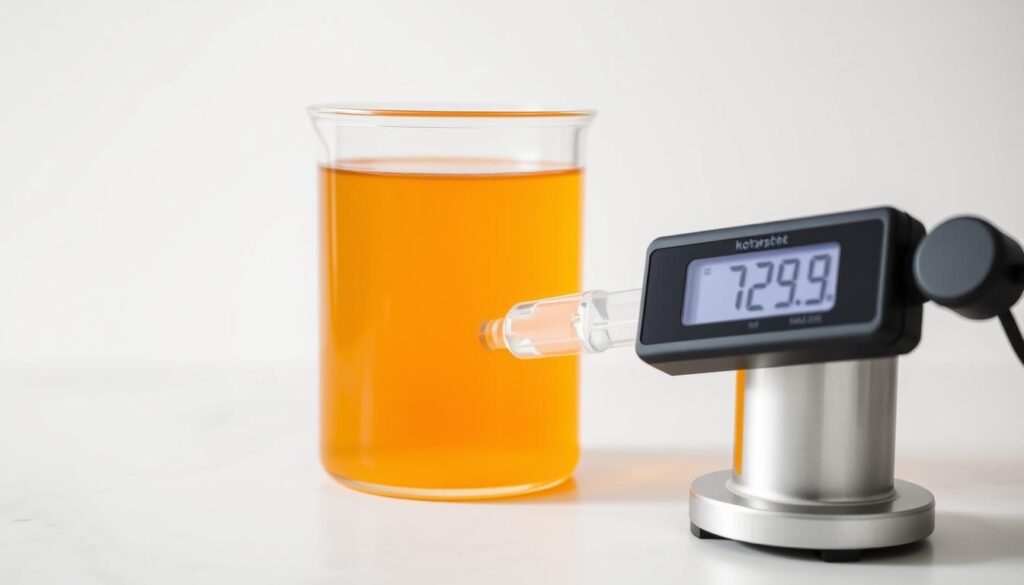
Making low carb kombucha means you need to watch sugar levels closely. This is key to keep your keto-friendly drinks within carb limits. Knowing how to check sugar content helps you stay in ketosis while enjoying your homemade kombucha.
There are a few important ways to measure sugar levels:
- Brix Refractometer: A scientific tool for precise sugar content evaluation
- Taste Testing: Identifying sweetness transitions
- pH Testing: Ensuring safety and flavor balance
The Brix refractometer is a great tool for sugar tracking. It shows sugar levels in grams per 100 mL of liquid. For keto-friendly kombucha, aim for under 2 grams of sugar in an 8-ounce serving.
| Measurement Method | Accuracy Level | Keto Compatibility |
|---|---|---|
| Brix Refractometer | High Precision | Excellent |
| Taste Testing | Moderate | Good |
| pH Strips | Moderate | Good |
To get the best results, mix different methods. Use the Brix refractometer for exact numbers, taste testing for feel, and pH strips for extra check. This way, your kombucha stays keto-friendly.
Pro tip: Longer fermentation times lower sugar, making your kombucha better for keto diets.
Low-Carb Flavoring Options
Making a tasty keto kombucha recipe doesn’t mean you have to give up flavor. As someone who loves healthy gut drinks, I’ve found great ways to add exciting low-carb flavors. These make your homemade kombucha both healthy and fun to drink.
The second fermentation is when the magic happens in your keto kombucha recipe. It’s a chance to try out unique flavors that are low in carbs.
Herb and Spice Combinations
Herbs and spices can really enhance your healthy gut drink without adding carbs. Here are some top picks for adding flavor:
- Ginger: 30g finely chopped per 3L batch, provides warming sensation
- Fresh mint leaves: Adds cool, refreshing undertone
- Basil: Brings unexpected herbal complexity
- Lavender: Introduces subtle floral notes
Fruit-Free Alternatives
If you’re looking for zero-carb flavors, these ingredients are perfect:
- Vanilla extract: Adds rich, smooth flavor
- Cinnamon sticks: Introduces warm, spicy dimension
- Dried rose petals: Creates elegant, delicate taste
- Star anise: Provides complex, licorice-like profile
When making your keto kombucha recipe, remember a little goes a long way. Start with small amounts and adjust to taste. These tips will help you make a delicious, low-carb healthy gut drink every time.
Extended Fermentation Techniques
Learning advanced probiotic drink recipes can change your kombucha brewing. Extended fermentation brings deeper flavors and better health benefits. It’s perfect for home brewers wanting to improve their kombucha.
Professional brewers know time and conditions matter a lot. The continuous brew method is a smart way to make low-sugar, high-probiotic kombucha.
Continuous Brew System Advantages
- Consistent fermentation environment
- Reduced sugar content
- Enhanced probiotic development
- Simplified brewing workflow
Temperature is key for fermentation success. Keeping it between 80-85°F helps microbes grow well. Also, controlling oxygen affects yeast, making the drink more complex and nutritious.
| Fermentation Technique | Sugar Reduction | Probiotic Intensity |
|---|---|---|
| Standard Brewing | 30-40% | Medium |
| Extended Fermentation | 50-70% | High |
| Continuous Brew | 60-80% | Very High |
Brewing kombucha is both science and art. Using these advanced tips, you’ll make a more complex, healthful drink. It’s more than just a recipe.
Troubleshooting Common Issues
Making a beginner kombucha recipe can be tricky, even for keto versions. Knowing common problems helps you make a tasty, healthy drink.
When you’re brewing low-carb kombucha, you might face some issues. Spotting and fixing these problems early on is key to a great drink.
Managing Carbonation Challenges
Getting the right amount of fizz in keto kombucha can be hard. The low sugar affects how much carbonation you get. Here’s how to boost it:
- Use tight-sealing bottles during second fermentation
- Add small amounts of keto-friendly sweeteners
- Maintain consistent room temperature between 72-78°F
- Allow sufficient fermentation time
Preventing Mold Growth
Stopping mold is vital in kombucha brewing. Keep your SCOBY safe with these tips:
- Keep brewing area clean and sanitized
- Maintain pH levels below 4.6
- Use filtered or distilled water
- Inspect brewing environment regularly
| Issue | Prevention | Solution |
|---|---|---|
| Low Carbonation | Consistent temperature | Add liquid stevia, extend fermentation |
| Mold Risk | Clean environment | Discard batch, sanitize equipment |
| Weak SCOBY | Proper starter tea | Refresh with healthy culture |
Learning these tips will boost your confidence in making keto kombucha. You’ll enjoy a tasty, low-carb probiotic drink every time.
Health Benefits and Nutritional Information

Keto kombucha is a top choice for gut health. It’s a probiotic drink that’s low in carbs but full of nutrients. It’s made from traditional kombucha, but with a keto twist.
This drink is great for those who care about their health. It has very little sugar. It also offers many health benefits:
- Supports digestive system functionality
- Enhances immune system response
- Provides beneficial probiotics
- Delivers antioxidants from fermented tea
Let’s look at what’s in keto kombucha:
| Nutrient | Amount per 8 oz Serving |
|---|---|
| Calories | 15-25 |
| Carbohydrates | 2-4g |
| Probiotics | 1 billion+ CFU |
| Organic Acids | 0.5-1g |
This probiotic drink is made through fermentation. It’s low in sugar but full of good stuff. It’s perfect for those following a keto diet.
Our keto kombucha has less sugar than regular kombucha. But it keeps the great taste and health benefits. Every batch is a chance to boost your gut health with a tasty, low-carb drink.
Tips for Maintaining Ketosis While Enjoying Kombucha
Adding low carb kombucha to a ketogenic diet needs careful planning. Most people on a keto diet try to eat less than 20 grams of carbs a day. This makes it important to control how much you drink.
Knowing how kombucha affects your body is key. Keep track of how much you drink to avoid too many carbs. I suggest drinking no more than 4-8 ounces a day to stay in ketosis.
- Choose homemade low carb kombucha with minimal sugar content
- Use stevia or monk fruit as sweetening alternatives
- Monitor total daily carbohydrate intake
- Test ketone levels regularly using blood or urine strips
When to drink kombucha is important. Drink it when you’re not as active, like mid-morning or early afternoon. This helps avoid insulin spikes and keeps your ketones steady.
Keeping track of what you eat lets you enjoy kombucha without breaking your keto diet. Pick low-sugar options and drink in moderation. This way, you can add this probiotic drink to your diet easily.
Conclusion
Making a tasty keto kombucha recipe is more than cooking—it’s a journey to a healthy drink. It supports your wellness goals. By learning the techniques we’ve shared, you can turn simple ingredients into a probiotic drink that fits your keto lifestyle.
Brewing kombucha needs patience, precision, and a love for trying new things. Every batch is a chance to get better and find a flavor you love. Don’t worry if you’re new; with time, you’ll make amazing keto kombucha.
Your homemade kombucha is a sign of your dedication to health and new ideas. It’s great for your gut or if you want a low-carb drink. This recipe mixes science with your creativity.
I encourage you to dive into this brewing adventure. Keep track of your progress and share it with others who love kombucha. Every batch is a chance to learn and might inspire others to improve their health.
